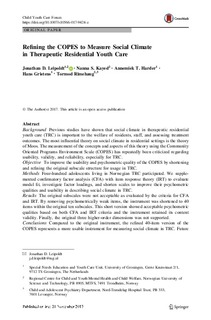| dc.contributor.author | Leipoldt, Jonathan David | |
| dc.contributor.author | Kayed, Nanna Sønnichsen | |
| dc.contributor.author | Harder, Annemiek T | |
| dc.contributor.author | Grietens, Hans | |
| dc.contributor.author | Rimehaug, Tormod | |
| dc.date.accessioned | 2017-12-15T08:56:48Z | |
| dc.date.available | 2017-12-15T08:56:48Z | |
| dc.date.created | 2017-12-14T10:55:15Z | |
| dc.date.issued | 2017 | |
| dc.identifier.citation | Child and Youth Care Forum. 2017. | nb_NO |
| dc.identifier.issn | 1053-1890 | |
| dc.identifier.uri | http://hdl.handle.net/11250/2472053 | |
| dc.description.abstract | Background
Previous studies have shown that social climate in therapeutic residential youth care (TRC) is important to the welfare of residents, staff, and assessing treatment outcomes. The most influential theory on social climate in residential settings is the theory of Moos. The measurement of the concepts and aspects of this theory using the Community Oriented Programs Environment Scale (COPES) has repeatedly been criticized regarding usability, validity, and reliability, especially for TRC.
Objective
To improve the usability and psychometric quality of the COPES by shortening and refining the original subscale structure for usage in TRC.
Methods
Four-hundred adolescents living in Norwegian TRC participated. We supplemented confirmatory factor analysis (CFA) with item response theory (IRT) to evaluate model fit, investigate factor loadings, and shorten scales to improve their psychometric qualities and usability in describing social climate in TRC.
Results
The original subscales were not acceptable as evaluated by the criteria for CFA and IRT. By removing psychometrically weak items, the instrument was shortened to 40 items within the original ten subscales. This short version showed acceptable psychometric qualities based on both CFA and IRT criteria and the instrument retained its content validity. Finally, the original three higher-order dimensions was not supported.
Conclusions
Compared to the original instrument, the refined 40-item version of the COPES represents a more usable instrument for measuring social climate in TRC. Future studies are needed to confirm the multifaceted refined short version in comparable samples of youth and staff to further investigate predictive value and construct validity. | nb_NO |
| dc.language.iso | eng | nb_NO |
| dc.publisher | Springer | nb_NO |
| dc.rights | Navngivelse 4.0 Internasjonal | * |
| dc.rights.uri | http://creativecommons.org/licenses/by/4.0/deed.no | * |
| dc.title | Refining the COPES to Measure Social Climate in Therapeutic Residential Youth Care | nb_NO |
| dc.type | Journal article | nb_NO |
| dc.type | Peer reviewed | nb_NO |
| dc.description.version | publishedVersion | nb_NO |
| dc.source.journal | Child and Youth Care Forum | nb_NO |
| dc.identifier.doi | https://doi.org/10.1007/s10566-017-9424-z | |
| dc.identifier.cristin | 1527235 | |
| dc.description.localcode | The Author(s) 2017. This article is an open access publication. | nb_NO |
| cristin.unitcode | 194,65,35,0 | |
| cristin.unitcode | 194,65,35,5 | |
| cristin.unitname | Institutt for psykisk helse | |
| cristin.unitname | RKBU Midt-Norge - Regionalt kunnskapssenter for barn og unge - psykisk helse og barnevern | |
| cristin.ispublished | true | |
| cristin.fulltext | original | |
| cristin.qualitycode | 1 | |

